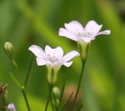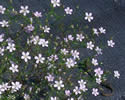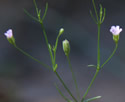Gypsophila muralis (Low Baby's Breath)
| Also known as: | Wall Baby's Breath, Annual Gypsophila |
|---|---|
| Genus: | Gypsophila |
| Family: | Caryophyllaceae (Pink) |
| Life cycle: | annual |
| Origin: | Europe |
| Status: |
|
| Habitat: | part shade, sun; dry, sandy or gravelly soil; lawns, gardens, sidewalk cracks, waste areas, roadsides, railroads |
| Bloom season: | July - September |
| Plant height: | 2 to 12 inches |
| Wetland Indicator Status: | none |
| MN county distribution (click map to enlarge): |  |
| National distribution (click map to enlarge): |  |
Pick an image for a larger view. See the glossary for icon descriptions.
Detailed Information
Flower: 


![[photo of flowers]](/udata/r9ndp23q/pd/gypsophila-muralis-7-t.jpg) Flowers are single at the tips of branching stems and arising on slender stalks from upper leaf axils. Flowers are ¼ to 3/8 inch across with 5 light pink to lavender petals with darker streaks, fused at the base into a slender tube. Inside the tube are 10 white stamens and a split style.
Flowers are single at the tips of branching stems and arising on slender stalks from upper leaf axils. Flowers are ¼ to 3/8 inch across with 5 light pink to lavender petals with darker streaks, fused at the base into a slender tube. Inside the tube are 10 white stamens and a split style.
![[photo of calyx]](/udata/r9ndp23q/pink/gypsophila-muralis-low-babys-breath_0726_121241-t.jpg) The calyx cupping the flower is about 1/8 inch long with 5 triangular lobes about half as long as the petals. Lobes are green with white edging that extends nearly to the base of the calyx, giving a green and white striped look. Flower stalks are slender and up to ¾ inch long. All parts are hairless. A robust plant has hundreds of flowers.
The calyx cupping the flower is about 1/8 inch long with 5 triangular lobes about half as long as the petals. Lobes are green with white edging that extends nearly to the base of the calyx, giving a green and white striped look. Flower stalks are slender and up to ¾ inch long. All parts are hairless. A robust plant has hundreds of flowers.
Leaves and stems: 

![[photo of upper leaves]](/udata/r9ndp23q/pd/gypsophila-muralis-6879-4-t.jpg) Leaves are opposite, lance-linear, pointed at the tip, stalkless at the base, toothless, hairless, the lower leaves up to 1 inch long, less than 1/8 inch wide, becoming smaller as they ascend the stem. Stems are slender, heavily branched throughout with forking branches, sparsely and minutely hairy near the base and hairless above.
Leaves are opposite, lance-linear, pointed at the tip, stalkless at the base, toothless, hairless, the lower leaves up to 1 inch long, less than 1/8 inch wide, becoming smaller as they ascend the stem. Stems are slender, heavily branched throughout with forking branches, sparsely and minutely hairy near the base and hairless above.
Fruit: 
Fruit is an oval-elliptic capsule about 1/8 inch long and longer than the calyx. It splits into 4 lobes when mature and contains numerous tiny, blackish, snail-shell-shaped seeds covered in rows of minute bumps.
Notes:
Low Baby's Breath is a native of Europe introduced in the garden trade and occasionally escapes cultivation, spreading into lawns, roadsides, cemeteries and other open, disturbed areas. An interesting account is noted in Flora of North America, where population expansions in Wisconsin have been blamed on winter activities of flooding sites for skating rinks, and where snow and ice have been piled up. One has to wonder where all that seed originated...and if it will likewise start spreading in Minnesota. Low Baby's Breath is recognized by its numerous tiny, delicate 5-petaled flowers, tubular calyx with a green and white striped appearance, opposite linear leaves, forking branches, and snail-shell-shaped seeds.
Native Plant Nurseries, Restoration and Landscaping Services ↓
More photos
 Low Baby's Breath plant
Low Baby's Breath plant Low Baby's Breath plant
Low Baby's Breath plant young Low Baby's Breath plant
young Low Baby's Breath plant robust Low Baby's Breath plant
robust Low Baby's Breath plant Low Baby's Breath in a lawn
Low Baby's Breath in a lawn
Photos by K. Chayka taken in Hubbard County. Photos courtesy Peter M. Dziuk taken in Anoka, Hubbard and Lake counties.
Comments
Have you seen this plant in Minnesota, or have any other comments about it?
on: 2019-03-01 23:12:45
Small patches show up every year in my gravel driveway.
on: 2023-09-28 16:29:04
One tiny, struggling plant in boulevard strip in front of my house, in dry, somewhat sparsely vegetated area. This plant appeared for the first time this spring and is still producing flowers. No more than 3 in high.






